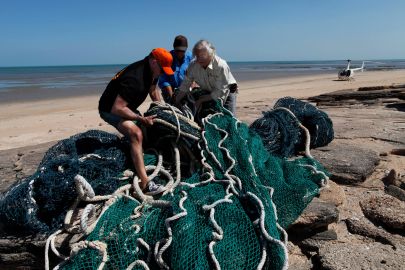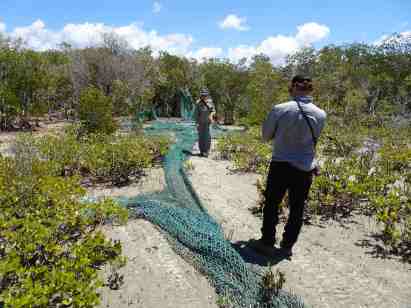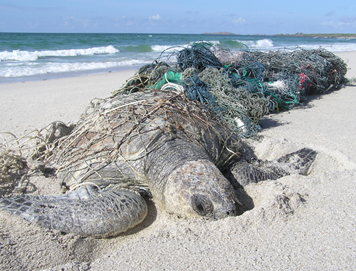Britta Denise Hardesty, Riki Gunn and Chris Wilcox
[Update of EMR feature – Riki Gunn, Britta Denise Hardesty and James Butler (2010) Tackling ghost nets: local solutions to a global issue in Northern Australia, Ecological Management & Restoration, 11:2, 88-98. https://onlinelibrary.wiley.com/doi/10.1111/j.1442-8903.2010.00525.x]
Key words. derelict fishing nets, ghost gear, GGGI, Indigenous livelihoods
Introduction. The focus of our 2009 feature was to highlight the work of Indigenous rangers in addressing the local but widespread problem of abandoned, lost or derelict fishing gear (ALDFG) in Northern Australia, particularly ‘ghost nets’ that are carried on the currents and continue to fish long after they are no longer actively used (Figs 1-4). We also aimed to raise awareness of the efforts required to address this complex issue, whilst highlighting the work of Indigenous rangers working in the region. The feature reported ghost net removal efforts taking place in Australia’s Gulf of Carpentaria – which, by 2009, involved the removal of 5532 nets by over 90 Indigenous rangers from more than 18 Indigenous communities. This highlighted the transboundary nature of the ghost gear issue, and identified that most nets likely originated from beyond Australia’s waters.

Figure 2. Napranum ranger Philip Mango releasing juvenile turtle trapped in ghost net. (Photo: Ghost Nets Australial)
Further work. Since 2010, the understanding of and approaches to addressing the derelict fishing gear issue have increased substantially. This has been reflected both in domestic efforts within Australia, and more broadly in the international community.
Domestically, in the last decade, the ranger program across northern Australia has evolved and grown, enabling more Indigenous people to remain culturally connected to their land and sea country through meaningful employment. Ranger activities generally involve a range of restoration activities including feral and weed management, in addition to (for coastal groups) ghost net removal. Across northern Australia, Indigenous ranger groups continue to remove nets on their country, demonstrating the success of the initial program supported by the Australian government. To date, nearly 15,000 ghost nets (three times the number reported in 2010) have been removed from the region. The net removal program has extended beyond Ranger groups working in the Gulf of Carpentaria to include the Torres Strait, the western part of the Northern Territory Coast, and parts of the Kimberly coastline in Western Australia.
Globally, the world is focused on the United Nations Sustainability Development Goals (SDGs) which aims to provide a ‘shared blueprint for peace and prosperity for people and the planet, now and into the future’ (https://sustainabledevelopment.un.org/sdgs).
A key focus for the SDGs is to help preserve the world’s oceans, a topic which touches on food security, poverty and economic growth, among other goals. Ensuring fishing practices are aligned with these goals includes reducing gear losses into the marine and coastal environment. In recognition of the issue and to end ALDFG, there is now a multi-stakeholder alliance of fishing industry, private sector, multinational corporations, non-government organizations, academics and governments, the Global Ghost Gear Initiative (GGGI), which is focused on solving the problem of abandoned, lost and derelict fishing gear worldwide. Both CSIRO and GhostNets Australia were founding members of this alliance and have been instrumental in engagement and scientific endeavours which inform the GGGI.

Fig 3. An enormous effort is invested by Indigenous rangers in removing ghost nets from beaches along the northern Australian coastline (Photo: World Animal Protection/Dean Sewell)
Based on collaborative research between GhostNets Australia and CSIRO, it was determined that the primary source of derelict nets washing ashore along Australia’s northern coastline was the Arafura Sea. Engagement with fishers in the region through a series of workshops identified that major causes of gear loss included snagging of nets and over-capacity in the region. We also identified opportunities to help resolve ghost net issues in the region, though stakeholder engagement, points of intervention and livelihood tradeoffs. Much of this overcapacity and overcrowding has been attributed to illegal, unreported and unregulated (IUU) fishing. Subsequently, Indonesia went through a substantial change in practices with regards to allowing foreign vessels in their waters, effectively closed their borders to foreign fisheries operators. Anecdotally, information from multiple ranger groups in Northern Australia suggests that this highly publicized and significant change in practice has resulted in a substantial decrease in the number of ghost nets washing ashore along at least part of the northern Australian coastline.
Another outcome from the collaborative research effort was a new understanding based on deep citizen science engagement and modelling to identify potential high risk areas where ghost nets were likely to cause the most harm to turtles. In this work, we were able to suggest interdiction points for ghostnets, before they entered the Gulf of Carpentaria where they were likely to kill wildlife. We also identified the nets that were most harmful to wildlife and we estimated that nearly 15,000 marine turtles had likely been killed by derelict nets in the region.
There have also been some technological improvements in this area. These fall into both reporting and in tracking nets. Electronic data collection has improved the quality of data collection and can ensure errors are minimised. Development of the tool has also been designed such that those with reduced literacy are also able to collect valuable information, a feature that can be important in many communities. Using icons and photos to help identify nets improved data reliability.
Also within Australia, alternative livelihoods programs such as Ghost Net Gear evolved into the Ghost Net Art Project where the art works have excited the International art community. This has resulted in purchases by many internationally renowned purveyors of artwork including the British Museum, the Australian National Museum and the Australian Maritime Museum. Works from Indigenous artists can also be seen at Australia’s Parliament House, and exhibitions have taken place in Monaco, Alaska, Singapore and France as well as in numerous national and regional galleries around Australia. A commemorative stamp was even made from the Ghost Nets artwork that lives in the Australian National Museum.

Figure 4. Large nets can become entangled in coastal vegetation. (Photo: World Animal Protection/Dean Sewell)
Future directions. While GhostNets Australia has not formally continued as a non-governmental organization, many of the components initiated through the program have continued and grown through time, as exemplified above. This early work also helped springboard CSIRO’s engagement in capacity building with the Indonesian government to tackle Illegal, Unreported and Unregulated (IUU) fishing. This had led to a strong research collaboration relationship between the two countries, with a shared goal of reducing IUU fishing, building capacity on marine resource management, and improved monitoring, control and surveillance efforts in Indonesia.
CSIRO is also involved in an aerial (re)survey of the coastline across Northern Australia. In affiliation with World Animal Protection and Norm Duke and Jock Mackenzie from James Cook University, we are looking at changes in the number of ghost nets along the shoreline (Figs 3 and 4). Stereo images were recorded along the entire coastline and we are comparing ghost nets observed across the region with two other aerial surveys that have taken place in the last decade. The team have just completed flights (September 2019), so we are looking forward to analysing the images and comparing ghost net numbers across the region.
Contact. Denise.hardesty@csiro.au; CSIRO Oceans and Atmosphere, Hobart, Tasmania, Australia. rikigunn1@outlook.com; chris.wilcox@csiro.au





